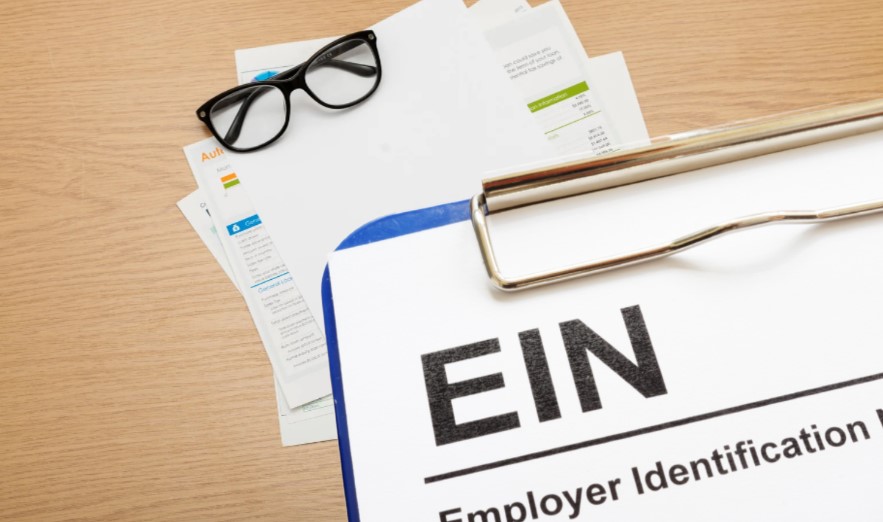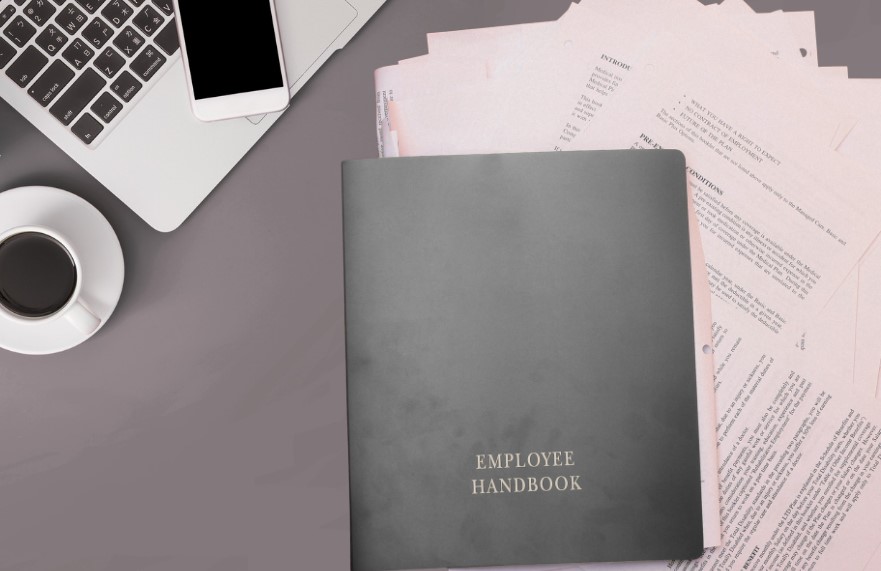Bringing on your first employee is a defining moment in the life of a small business. It signals growth, a busier schedule, and the chance to share the workload that once fell entirely on your shoulders.
Yet, that excitement comes with a new level of responsibility. Hiring introduces legal obligations that, if ignored, can lead to fines, disputes, or serious financial headaches.
To make that first hire smooth and legally sound, you need a clear, actionable plan. Today, we will walk you through everything you need before your new hire clocks in for the first time.
Table of Contents
Toggle1. Obtain an Employer Identification Number (EIN)

Before you can pay wages or withhold taxes, your business must have an Employer Identification Number. Think of the EIN as a Social Security number for your company.
How to Get It
- Visit the IRS website and submit Form SS-4 online.
- You’ll need your personal taxpayer identification number and basic business details.
- It’s free, and in most cases, the number is issued immediately.
Why it Matters
Without an EIN, you cannot file payroll taxes, open a business bank account in your company’s name, or report employee wages.
Example
A bakery owner applies for an EIN before hiring a part-time cashier. This allows the bakery to set up payroll and meet IRS reporting rules from day one.
2. Register with Your State’s Labor Department
Most states require new employers to register for unemployment insurance and new hire reporting.
Steps to Take
- Contact your state labor department or unemployment insurance office. A national list of state agencies is available here.
- Provide your EIN, business name, and other required details.
- Some states auto-enroll you when you file your first state tax return, but don’t assume – double-check.
Example
A tech startup in California submits Form DE-1 to the Employment Development Department to get a state employer account number for payroll reporting.
3. Secure Workers’ Compensation Insurance
Workers’ compensation insurance is required in most states once you hire employees. It covers medical costs and lost wages if someone gets hurt on the job.
How to Obtain Coverage
- Contact insurers licensed in your state.
- Compare rates based on job roles and industry risk.
- Confirm whether your state allows exemptions for very small businesses.
If you need to explore your options for injury claims, click here.
Example
A landscaping company in Texas purchases workers’ compensation insurance to protect against injuries from equipment use, preventing both lawsuits and out-of-pocket expenses.
4. Set Up a Payroll System
Payroll is about more than cutting checks. You must withhold the correct federal and state taxes and submit them on time.
Options
- In-house: Use software like QuickBooks, but be prepared to handle all tax calculations yourself.
- Third-party services: Platforms like Gusto or ADP handle withholdings, direct deposits, and tax filings for a fee.
Key Withholdings Include
- Federal income tax (based on Form W-4)
- Social Security tax (6.2% of wages)
- Medicare tax (1.45% of wages)
- State income tax where applicable
Example
A freelance designer hires an assistant and uses Gusto to automate payroll, ensuring taxes are filed accurately without added stress.
5. Correctly Classify Your Workers

Hiring someone doesn’t always mean you’re bringing on an employee. Some roles are better suited to independent contractors, and misclassification can trigger penalties.
Key Differences
- Employees: You control schedules, methods, and tools. Taxes are withheld, and benefits may apply.
- Independent contractors: They work for multiple clients, use their own tools, and handle their own taxes.
Use IRS guidelines to evaluate behavioral and financial control.
Example
A startup hires a freelance developer for a one-time project. The developer uses personal equipment and invoices for services, avoiding employee misclassification.
6. Verify Employment Eligibility with Form I-9
Every U.S. employer must confirm that an employee is legally authorized to work.
Steps
- Employee completes Section 1 of Form I-9 on or before their first day.
- You review and record ID documents (passport, driver’s license plus Social Security card, etc.) and complete Section 2 within three business days.
- Keep the form on file for three years after hire or one year after employment ends.
Example
A retail shop verifies a new cashier’s documents, fills out Form I-9, and secures it in a locked cabinet for compliance.
7. Have Employees Complete Form W-4
Form W-4 tells you how much federal income tax to withhold from an employee’s paycheck.
Action Steps
- Provide the form on day one.
- If it’s not returned, withhold as if the employee is single with no allowances.
Example
A consulting firm’s new hire claims two allowances on their W-4, which the employer uses to set the correct withholdings.
8. Report New Hires to Your State
States require employers to report new hires to support child support enforcement and fraud prevention.
How to Report
- Submit employee name, address, Social Security number, hire date, and your EIN within 20 days.
- Check your state’s website or the National Directory of New Hires for submission options.
Example
A restaurant owner in New York submits a new server’s info to the state registry the same week they start.
9. Create an Employee Handbook

Even if you only have one employee, a handbook sets expectations and protects your business.
What to Include
- Mission and values
- Attendance and scheduling policies
- EEO and anti-harassment guidelines
- Safety and health rules
- PTO and leave policies
- Disciplinary procedures
Example
A tech startup provides a handbook outlining remote work and anti-discrimination policies, signed by the new hire as acknowledgment.
10. Post Required Workplace Notices
Federal and state laws require specific posters that inform employees of their rights.
Common Examples
- Equal Employment Opportunity (EEO)
- Fair Labor Standards Act (FLSA)
- OSHA safety poster
- FMLA poster (if applicable)
Download posters from the Department of Labor. For remote workers, digital copies or intranet postings work.
Example
A small office displays EEO and OSHA posters in the break room to stay compliant.
11. Conduct Background Checks (Optional)
If your industry demands trust or safety, a background check can reduce risk.
Compliance Tips
- Follow the Fair Credit Reporting Act (FCRA).
- Obtain written consent before any check.
- Use the information only for job-related decisions.
Example
A childcare center verifies criminal history for a new teacher, following FCRA and state requirements.
12. Draft a Clear Offer Letter
An offer letter puts the job details in writing and avoids miscommunication.
Include
- Job title and duties
- Start date and pay
- Benefits and hours
- At-will employment language (where applicable)
Example
A marketing firm sends an offer letter confirming a $50,000 salary, remote options, and at-will status.
13. Use Confidentiality Agreements

If your business handles sensitive data or intellectual property, require a signed NDA.
Include
- Definition of confidential info
- Duration of confidentiality
- Consequences for breaches
Example
A software startup requires its first developer to sign an NDA to protect proprietary code.
14. Comply with OSHA Workplace Safety Rules
A safe workplace is a legal requirement. OSHA enforces safety standards for all industries.
Key Actions
- Provide a hazard-free environment
- Train employees on safety protocols
- Keep records of incidents
Example
A small construction business conducts equipment training to meet OSHA standards before the first hire starts work.
15. Consider Employee Benefits
Benefits can boost retention and, in some cases, are required by law.
Popular Benefits
- Health insurance
- 401(k) or retirement plans
- PTO and sick leave
- Disability or life insurance
State-Specific Alerts
- Illinois requires PTO for all employers starting 2024.
- Cities like Chicago may have even stricter leave rules.
Example
A local shop offers a 401(k) match to its first employee to create a positive work environment.
16. Obtain Additional Insurance
Beyond workers’ comp, other coverage protects your company from unexpected financial risk.
Types of Insurance
- General liability for injuries or property damage
- Directors and officers’ coverage for legal claims against key individuals
- Commercial rental insurance for leased spaces
Example
A small retail store buys general liability insurance to cover potential slip-and-fall incidents.
17. Keep Detailed Records

Proper record-keeping is non-negotiable. It proves compliance and shields you in disputes.
Store
- Personnel files and signed agreements
- Payroll and tax records (at least four years)
- I-9 forms (three years after hire or one year after termination)
Example
A startup maintains encrypted digital files for all employee forms, ensuring security and legal compliance.
18. Stay on Top of State-Specific Laws
Employment laws vary by state, affecting everything from minimum wage to paid leave.
Examples
- California: $15 minimum wage
- Federal: $7.25 minimum wage
- Some states mandate family or sick leave
Always check your state’s labor department website or consult an attorney for updates.
Legal Checklist Summary Table
| Step | Action | Key Forms/Documents | Resources |
| 1. Obtain EIN | Apply online | Form SS-4 | IRS.gov |
| 2. State Registration | Register for unemployment | State forms | Doleta.gov |
| 3. Workers’ Comp | Buy insurance | Policy | State providers |
| 4. Payroll Setup | In-house or third-party | IRS Pub 15 | IRS.gov |
| 5. Classify Workers | Determine status | IRS Guidelines | IRS.gov |
| 6. Verify I-9 | Complete Form I-9 | I-9 Form | USCIS.gov |
| 7. W-4 Form | Employee completes | Form W-4 | IRS.gov |
| 8. New Hire Reporting | Submit to state | Report form | ACF.gov |
| 9. Employee Handbook | Outline policies | Handbook | Templates online |
| 10. Required Notices | Display posters | EEO, OSHA | DOL.gov |
| 11. Background Check | With consent | FCRA disclosure | Legal counsel |
| 12. Offer Letter | Detail job terms | Offer letter | Templates |
| 13. NDA | Protect IP | NDA form | Legal templates |
| 14. OSHA Compliance | Train and document | Safety logs | OSHA.gov |
| 15. Benefits | Offer or mandate | Benefit docs | State and federal |
| 16. Extra Insurance | Liability, rental | Policies | Providers |
| 17. Records | Keep 3-4 years | Personnel/tax | IRS.gov |
| 18. State Laws | Review annually | Varies | State labor sites |
Final Thoughts
Hiring your first employee marks the start of a new chapter for your business. It’s a chance to grow, delegate, and scale – but only if your legal foundation is solid. By working through this checklist, you give your business the structure to thrive while protecting yourself from costly missteps.
For state-specific issues or anything that feels unclear, consult an HR or employment attorney. A little preparation now will save a lot of stress later – and help you focus on what matters most: building your team and watching your business grow.



